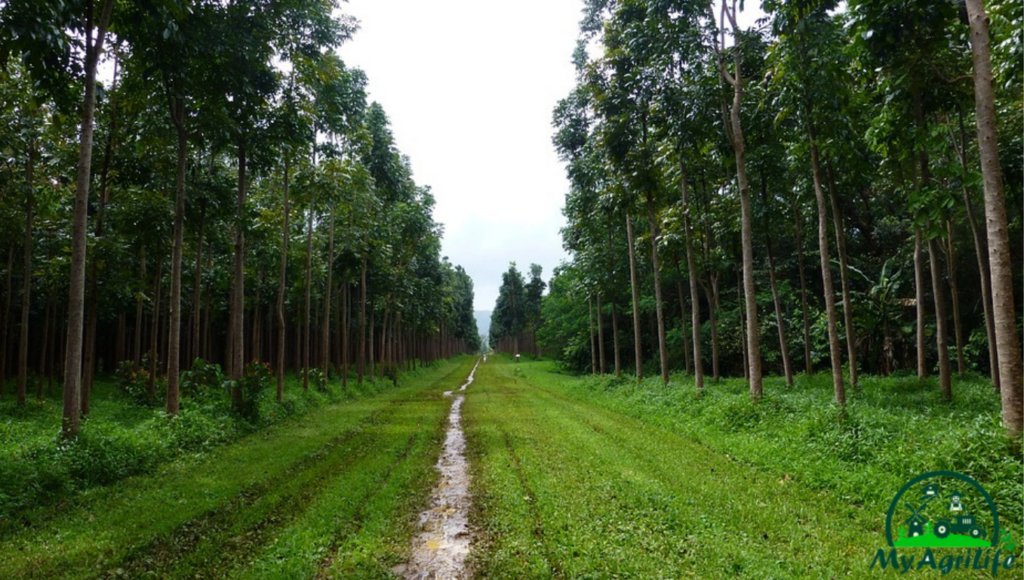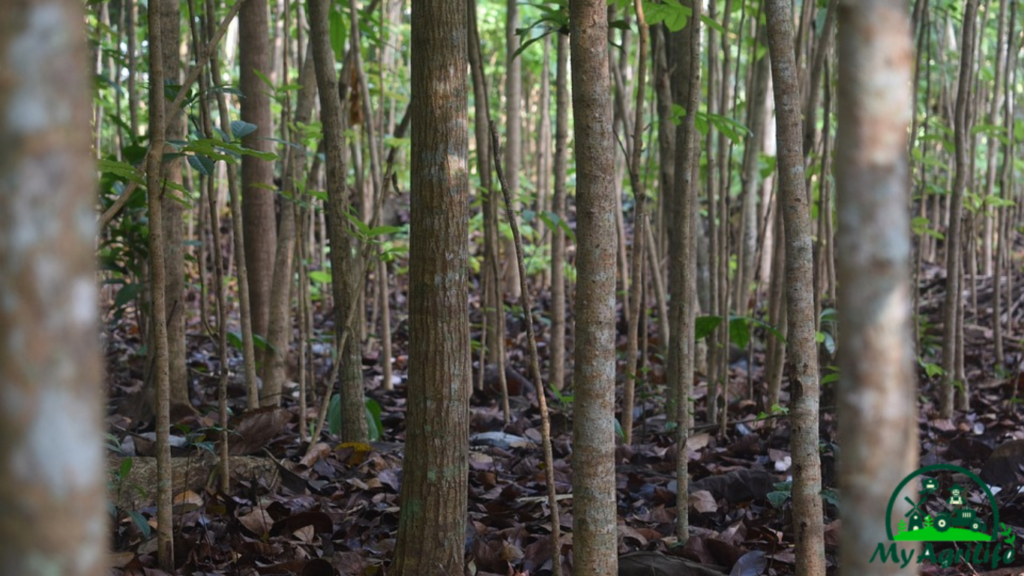
Mahogany Tree is a large tropical tree that is highly valued for its beautiful and durable wood. It belongs to the family Meliaceae and is scientifically known as Swietenia mahagoni. It is native to the Americas, including southern Florida, the Caribbean, and parts of Central and South America.
The mahogany tree can grow up to 40 meters tall and has a straight trunk with a diameter of up to 1.5 meters. The bark is smooth and grayish-brown, and the leaves are dark green and glossy, with a pinnate shape. The tree produces small, fragrant flowers that are usually pink or purple in color. The fruit of the tree is a large, woody capsule that contains up to 50 winged seeds.
Mahogany wood is highly prized for its strength, durability, and beauty. It has a reddish-brown color and a straight grain, and is commonly used for furniture, cabinetry, flooring, and musical instruments. Due to the high demand for mahogany wood, the tree has been overexploited in many areas, leading to a decline in its population. It is now protected under international agreements and is listed as a vulnerable species by the International Union for Conservation of Nature (IUCN).
Seed Specification Mahogany Tree
The seeds of the Mahogany tree (Swietenia mahagoni) are typically small, flattened, and winged. The seed pods are large, woody capsules that split open to release the seeds. Here are some specifications for Mahogany tree seeds:

1.Size: The seeds are typically about 2-3 cm in length and 1-2 cm in width.
2.Weight: The weight of each seed is usually around 1-2 grams.
3.Germination: Mahogany tree seeds have a variable germination rate, but they can typically germinate within 2-4 weeks under favorable conditions.
4.Viability: Mahogany tree seeds can remain viable for up to 5 years if they are stored properly in a cool, dry place.
5.Propagation: Mahogany tree seeds can be propagated by sowing them directly into the soil or by starting them in pots and transplanting them later. The seeds should be sown at a depth of about 1 cm and kept moist but not waterlogged.
It’s important to note that Mahogany trees are slow-growing and can take several years to reach maturity. They also require a warm, humid climate and well-drained soil to thrive. Therefore, Mahogany tree seeds should only be planted in suitable growing conditions and with proper care and attention.
Land Preparation & Soil Health Mahogany Tree
Mahogany trees (Swietenia mahagoni) prefer well-drained, fertile soils with a pH between 6.0 and 7.5. They grow best in tropical or subtropical regions with an annual rainfall of 1,000-2,000 mm, and temperatures between 20°C and 30°C.

Here are some steps for land preparation and improving soil health for Mahogany tree cultivation:
1.Clear the land: Clear the land of any weeds, rocks, or debris that may interfere with tree growth.
2.Soil testing: Conduct a soil test to determine the soil’s pH, nutrient levels, and other characteristics. This will help you determine what soil amendments may be needed to optimize tree growth.
3.Soil amendments: Based on the results of the soil test, add soil amendments as needed to improve soil fertility and structure. Common amendments include organic matter (such as compost), phosphorus, and potassium.
4.Tilling: Till the soil to a depth of about 30 cm to create a loose, aerated soil bed that promotes root growth.
5.Drainage: Ensure that the site has adequate drainage to prevent waterlogging, which can be detrimental to the growth of Mahogany trees.
6.Mulching: Apply a layer of organic mulch around the base of each tree to help conserve soil moisture and suppress weed growth.
7.Crop rotation: To prevent soil depletion, rotate Mahogany tree cultivation with other crops that do not deplete the soil of nutrients.
By following these steps, you can prepare the land and improve the soil health to support healthy growth of Mahogany trees. It’s also important to monitor the soil health regularly and make adjustments as needed to ensure the best possible growing conditions for the trees.
Crop Spray & Fertilizer Specification Mahogany Tree
Crop spray and fertilizers can be used to improve the growth and health of Mahogany trees (Swietenia mahagoni). Here are some specifications for crop spray and fertilizers for Mahogany tree cultivation:
1.Crop spray: Crop sprays can help control pests and diseases that can damage Mahogany trees. Before applying any spray, it’s important to identify the specific pest or disease and choose a spray that is effective against it. In general, it’s best to use organic or natural sprays that are safe for the environment and beneficial insects. Some examples of crop sprays for Mahogany trees include neem oil, garlic oil, and pyrethrin.
2.Fertilizers: Fertilizers can provide essential nutrients that promote the growth and health of Mahogany trees. Before applying any fertilizer, it’s important to conduct a soil test to determine the specific nutrient needs of the trees. Fertilizers should be applied in the right amount and at the right time to avoid over-fertilization, which can damage the trees. Some specifications for fertilizers for Mahogany trees include:
Nitrogen: Mahogany trees require moderate amounts of nitrogen for healthy growth. A balanced fertilizer with an NPK ratio of 10-10-10 or 15-15-15 can be used.
Phosphorus: Phosphorus is essential for root development and flower and fruit production. A fertilizer with a higher phosphorus content (such as a 10-20-10 or 10-30-10) can be used during the early stages of growth.
Potassium: Potassium is important for overall tree health and stress tolerance. A fertilizer with a higher potassium content (such as a 10-5-20) can be used during the later stages of growth.
It’s important to apply fertilizers evenly and avoid direct contact with the trunk or foliage of the trees, as this can cause damage. Additionally, fertilizers should be applied at the right time of year, typically during the active growing season.
Weeding & Irrigation Mahogany Tree
Weeding and irrigation are important aspects of maintaining healthy and productive Mahogany trees (Swietenia mahagoni). Here are some specifications for weeding and irrigation for Mahogany tree cultivation:

1.Weeding: Weeds can compete with Mahogany trees for water and nutrients, which can stunt their growth and reduce their productivity. To control weeds, it’s important to implement a regular weeding schedule. Manual weeding can be done with hand tools, or herbicides can be used. However, it’s important to choose herbicides that are safe for the environment and the trees, and to apply them only as directed.
2.Irrigation: Mahogany trees require consistent moisture to thrive, especially during their early growth stages. Irrigation should be done on a regular basis, especially during dry spells or drought conditions. The amount of water required depends on the soil type, weather conditions, and stage of growth. Generally, young trees require more frequent watering, while mature trees can tolerate drier conditions. Drip irrigation is a preferred method of watering for Mahogany trees as it delivers water directly to the roots and reduces water loss due to evaporation.
3.Mulching: Mulching can help conserve soil moisture and suppress weed growth, which reduces the need for irrigation and weeding. Organic mulch such as compost, wood chips or leaves can be used around the base of each tree. It is important to apply the mulch about 2-3 inches thick, and keep it away from the tree’s trunk to prevent rot.
By implementing a regular weeding schedule, providing consistent irrigation, and using organic mulch around the base of the tree, you can help ensure healthy growth and productivity of your Mahogany trees. It’s important to monitor the moisture level of the soil and adjust irrigation as needed to avoid overwatering, which can cause root rot and other issues.
Harvesting & Storage Mahogany Tree
Harvesting and storage are critical aspects of Mahogany tree (Swietenia mahagoni) cultivation, as they can impact the quality and value of the wood. Here are some specifications for harvesting and storage of Mahogany trees:
1.Harvesting: Mahogany trees are typically harvested when they are mature, which can take anywhere from 15 to 25 years depending on the growing conditions. It’s important to wait until the tree has reached its full potential, as this can result in higher quality wood. The best time to harvest is during the dry season, as the wood is less likely to develop cracks or splits during this time. Harvesting should be done carefully to avoid damaging the tree or the surrounding trees.
2.Storage: After harvesting, the logs should be stored in a dry, well-ventilated area to prevent decay or insect infestation. It’s important to stack the logs in a way that allows for air circulation and to keep them off the ground to prevent moisture damage. The ideal moisture content for Mahogany wood is around 12%, and it’s important to monitor the moisture content of the wood during storage to prevent it from getting too dry or too wet.
3.Processing: After storage, the logs can be processed into lumber or other wood products. This process involves cutting the logs into boards, drying the wood to the proper moisture content, and planing and sanding the wood to achieve the desired finish. It’s important to use proper safety equipment during processing, such as goggles, earplugs, and dust masks.
By following these specifications for harvesting, storage, and processing, you can help ensure that your Mahogany wood is of high quality and value. It’s important to take care when harvesting and storing the wood to prevent damage or decay, and to monitor the moisture content of the wood during storage to prevent it from becoming too dry or too wet.
Conclusion
In conclusion, Mahogany tree (Swietenia mahagoni) farming can be a lucrative and sustainable venture when done properly. To cultivate healthy and productive Mahogany trees, it’s important to prepare the land and maintain soil health, use appropriate crop sprays and fertilizers, implement regular weeding and irrigation, and carefully harvest and store the wood. By following these specifications and best practices, farmers can help ensure that their Mahogany trees grow to their full potential and produce high-quality wood that is valued for its beauty and durability. It’s also important to stay up to date with the latest research and technology in Mahogany tree farming to continually improve yields and sustainability.









